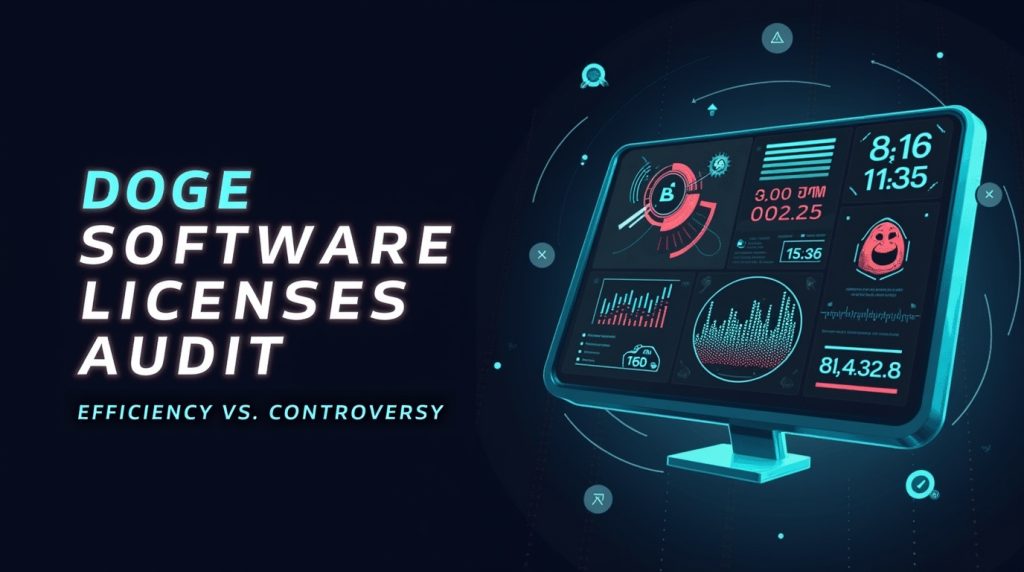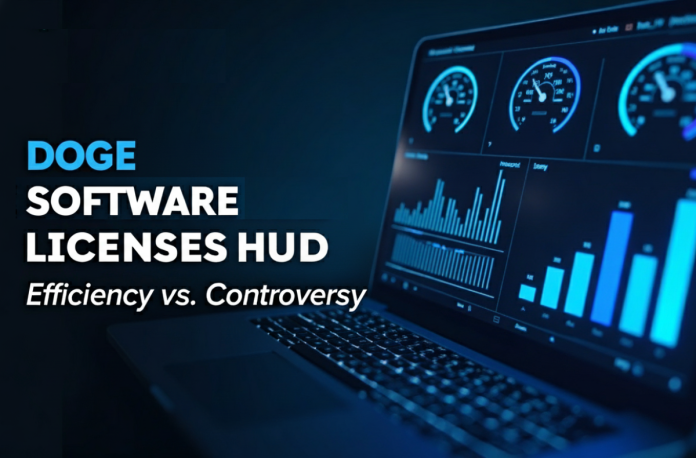Every year, the federal government spends billions of dollars on IT. But how many of them are going to waste? The DOGE software licenses audit HUD case puts this question in the spotlight for systematic review. The newly established oversight body, the Department of Government Efficiency, which Elon Musk proposed, has announced the results of the replicated finding. They found massive software license waste in most federal agencies. The most prominent example was the Department of Housing and Urban Development (HUD). DOGE alleged that thousands of unused Adobe licenses were essentially collecting dust, costing the U.S. taxpayer millions.
This audit sparked considerable controversy. On one side, several hailed the DOGE software licenses audit HUD as an exposure of systemic waste. On the other hand, IT procurement experts rebutted that the evidence-sharing was based on a misunderstanding of enterprise software licensing. Here, we aim to describe the contentious situation involving the DOGE software licenses audit HUD. We present evidence and explain what it means for Government IT spending and Software Asset Management (SAM).
Key Takeaways
- The DOGE software licenses audit HUD found significant waste, estimating that thousands of unused licenses cost taxpayers millions.
- This audit highlights the need for real-time monitoring and management of software licenses to improve efficiency and reduce costs.
- Critics argue that labeling licenses as ‘unused’ oversimplifies the complexities of enterprise software licensing practices.
- The initiative led to immediate actions from agencies like HUD and GSA, resulting in significant cost savings and license optimization.
- Organizations can adopt DOGE software licenses audit HUD practices to enhance IT spending transparency and accountability.
Table of Contents
Understanding the DOGE Software Licenses Audit HUD
The DOGE software licenses audit HUD is more than a one-time audit. It represents a prospect model for continuous oversight. The DOGE software licenses audit HUD is a continuous visibility system, or a “Heads-Up Display.” It is designed to keep track of where and how software licenses are being deployed in real-time. This model determines the compliance rates of software licenses. It also identifies which licenses are not being utilized. In the Government organization, it also assesses the amount of Government IT spending that is being wasted.
Key elements of a DOGE software licenses audit HUD system are as follows:
- Real-Time Monitoring: It tracks license allocation and usage in real-time.
- Cost Savings: Identifies and eliminates inactive, simply ordinary, or duplicative licenses.
- Risk Reduction: Avoids legitimate consequences for non-compliance with complicated licensing terms.
- Operations Command: It consolidates all software assets to provide decision-making personnel with the best view.
The DOGE software licenses audit HUD represents a shift from occasional, manual inspection methods. It moves to a modernized preventative strategy for IT asset management. For large enterprises, as well as Government enterprises subject to complex Federal government licensing policies, this active approach has become essential.
The HUD Controversy: 11,020 Unused Adobe Licenses?
The controversy ignited when DOGE, often via social media, reported that its audit found 11,020 unused Adobe Acrobat licenses at HUD. This was just one of several startling DOGE initiative findings.
| Software | Total Licenses | Active Users |
|---|---|---|
| Adobe Acrobat | 11,020 | 0 |
| ServiceNow | 35,855 | 84 |
| Cognos | 1,776 | 325 |
| WestLaw Classic | 800 | 216 |
| Java | 10,000 | 400 |
These particular numbers undoubtedly illustrate high inefficiency. However, critics quickly questioned the methodology of the DOGE software licenses audit HUD. They argued that saying those software licenses were “unused” is an oversimplified explanation.
Many large organizations, especially those in the Adobe government sector, purchase extra user licenses at discounted prices. They do this compared to buying one on an as-needed basis. In addition to a higher headcount than calculated from the required licenses, it is common to maintain additional storage volumes. This approach is particularly beneficial for large companies. It enables painless short-term workforce adjustments. For example, hiring more specialists for a new project or a temporary framework, and “firing” the old ones by terminating their support.
In response to such critics, HUD claimed that those licenses were part of a long-term contract. They argued the more advanced ones were stored for future integration with new employees. There is a certain trade-off between the inconvenience of owning several terabytes of unused capacity at any given time and the potential damage that may occur in the future. This includes significant workflow delays and increased costs per user through purchasing methods. This underlying question in enterprise software licensing practices was one of the main points conveyed by the DOGE software licenses audit HUD.

Real Impact and Cost-Saving Strategies
Regardless of the nuances, the DOGE software licenses audit HUD had an undeniable impact. It spurred immediate action. Kasey Lovett, a HUD spokesperson, confirmed a task force was actively working to remedy the software license waste.
The General Services Administration was a good example of the potential savings. DOGE audit found similar deficiencies, such as 37,000 WinZip licenses for 13,000 GSA employees. The administrator of GSA acted upon the data findings within 1 hour. DOGE claims that the action resulted in the deletion of 114,163 unused licenses, and they also discarded 15 duplicate software programs. The actions resulted in a savings of $9.6 million.
These events all indicate the power of transparency to foster frugality in government IT spending. The action of DOGE software licenses audit HUD, and GSA made headlines, becoming a source of humiliation. They create pressure for the executive to address underlying issues. This is a compelling case for any large organization seeking to initiate a software license optimization (SLO) initiative.
Components and Workflow of a DOGE-Style Audit HUD
So, how does a DOGE software licenses audit HUD actually work? A comprehensive Software Asset Management (SAM) dashboard solution involves several key components that work together to provide real-time insights.
Key Components
- License Inventory Tracking: The system scans code repositories, deployment manifests, and other IT systems. It does this as often as necessary to maintain a complete inventory of all software in use or marked for potential deployment.
- Real-Time Compliance Dashboard: This represents “the HUD” itself. It provides a visual, real-time, and at-a-glance overview of license compliance or violations, remaining days, renewal dates, and usage trends.
- Policy and Rule Engine: Administrators can configure rules in the HUD. This determines the status of approved, flagged for review, and outlawed licenses. Thus, approving most licenses and reducing the confusion over compliance is automatic.
- Automated Reporting and Audit Trails: The system continuously generates detailed compliance reports upon request. It also provides a comprehensive audit trail, which is crucial for reconciling licenses across the government and during regulatory reviews.
- Analytics and Optimization Insights: Advanced analytics identify cost-saving opportunities. These can be realized through the managed use of software. This includes identifying underutilized software or suggesting the consolidation of application types.
- Integration Ecosystem: The HUD should be well-integrated with existing systems. These include, but are not limited to, GitHub, your CI/CD pipelines, and IT service management solutions (such as ServiceNow).
The Workflow
- Discovery: All software assets are inventoried by the system
- Identification: Each asset is matched to its license metadata
- Evaluation: Usage is compared against policy rules, while non-compliance is highlighted
- Live Updates: Compliance status is provided in real-time through the dashboard
- Alerting: Proactive alerting is maintained to bring issues to awareness as they occur
- Reporting: Audit-ready reports are auto-generated.
Such an automated workflow package makes the DOGE software licenses audit HUD a formidable force in Federal IT acquisition reform for any organization.

Best Practices to Avoid Software License Waste
From the DOGE software licenses audit HUD, one can learn valuable lessons for any organization, either in the public or private sector. Don’t allow your organization to fall into the same trap of software license waste.
Here’s what you need to do to avoid becoming the next DOGE.
- Centralize License Management: Keep a single authoritative repository in which you store all software licenses, contracts, and renewal dates. This will prevent siloed procurement and provide you with a comprehensive view of Government IT spending.
- Implement Real-Time Dashboard: Use a DOGE software license audit HUD style for ongoing monitoring. The annual audit is too little, too late.
- Negotiate Flexible Contracts: Collaborate with your vendor, such as Adobe, to secure enterprise agreements that offer flexibility. For example, a license pooling or a true-up based on actual usage.
- Automate Onboarding and Offboarding: Make your IT asset management integrate with HR systems. This will automatically assign and reclaim licenses every time an employee joins, moves, or leaves your organization.
- Cultivate a Culture of Accountability: The DOGE software licenses audit HUD indicates that transparency is key. No one attempted to use the licenses because no one knew they could be used. Promote responsibility, and your asset utilization will naturally increase.
Follow these steps, and you can turn Software Asset Management from a reactive, compliance-driven task into a proactive, value-adding business function.
The Future of Government IT Efficiency
The DOGE software licenses audit HUD is more than a story about DOGE Adobe licenses. It’s a turning point in the struggle for a more responsible and tailored IT setup. The method of DOGE software licenses audit HUD uncovered many distasteful, unethical, and procedural practices. However, the achievements could not be dismissed. It revealed that when complemented with transparency and the appropriate software products, the insurmountable inertia of the bureaucracy can be overcome to save money.
The message is clear to IT authorities in government and business as well: software license optimization (SLO) cannot proceed proactively. The DOGE software licenses audit of the HUD system proves that technology is available to monitor Government IT expenditures and remove waste in real-time. While ambitious and overreaching in several respects, the DOGE Software Licenses Audit HUD audit has effectively laid the foundation for a future. In this future, all dollars spent on technology are accounted for and optimized.
FAQs
The DOGE software licenses audit HUD was an initiative by the Department of Government Efficiency that utilized a real-time dashboard aimed at disseminating findings about wasteful software licenses within the Department of Housing and Urban Development.
While the licenses were unassigned, it is misleading to say they were “unused.” In normal routines, most large organisations purchase software licenses in bulk, knowing they will likely need more in the future. However, this kind of controversy reveals the misunderstanding between commercial procurement practices and the pressure to be a perfectly efficient machine.
The DOGE is an independent advisory body for Government Efficiency, proposed and supported by Elon Musk. It is not even a formal cabinet-level agency.
These audits prompted multiple agencies, including HUD and the GSA, to implement quick remedial measures. According to the latter, they save the Government $9.6 million yearly by eradicating unused licenses and redundant software. Thus, the initiative was highly effective.
Absolutely. The systematic approach of DOGE software licenses audit HUD is universal. Any organization that desires to optimize its IT spending, organize software license compliance, and avoid waste can benefit from a real-time Software Asset Management (SAM) system.











